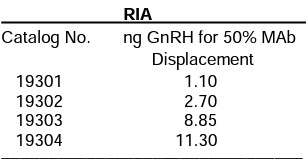Anti-Gonadotropin Releasing Hormone Antibody
Anti-Gonadotropin Releasing Hormone Antibody
Product No.: 19301
- -
- -
Clone LHRH13-327.8 Target Gonadotropin Releasing Hormone Formats AvailableView All Product Type Monoclonal Alternate Names Progonadoliberin I [Cleaved into: Gonadoliberin-1 Isotype Mouse IgG1 Applications ELISA , IHC , RIA |
Data
- -
- -
Antibody DetailsProduct DetailsReactive Species Human Host Species Mouse Immunogen Purified human GnRh Product Concentration Lot Specific Formulation This monoclonal antibody is formulated in phosphate buffered saline (PBS) pH 7.2 - 7.4 with no carrier protein or preservatives added. State of Matter Liquid Product Preparation Antibodies are purified by a multi-step process including the use of protein A or G to assure extremely low levels of endotoxins, leachable protein A or aggregates. Storage and Handling Upon initial thawing, appropriately aliquot and store at -80°C. For long-term storage, keep at -80°C. Avoid repeated freeze-thaw cycles. Country of Origin USA Shipping Next Day 2-8°C Applications and Recommended Usage? Quality Tested by Leinco These antibodies have been qualified for use in ELISA, immunohistochemistry, and RIA to detect human GnRH.
Endusers should determine optimal concentrations for their applications.RIA Each investigator should determine their own optimal working dilution for specific applications. See directions on lot specific datasheets, as information may periodically change. DescriptionDescriptionSpecificity This antibody recognize human GnRH. Background Gonadotropin-releasing hormone (GnRH), also known as luteinizing hormone-releasing hormone (LHRH), is a 10 amino acid neurohormone produced in the hypothalamus. GnRH stimulates the synthesis and secretion of the two gonadotropins—luteinizing hormone (LH) and follicle stimulating hormone (FSH)—by the anterior pituitary gland. Characteristic of all releasing hormones, and most striking in the case of GnRH, is the phenomenon of pulsatile secretion. Under normal circumstances, GnRH is released in pulses at intervals of about 90 to 120 minutes. Abnormalities in the pulsatile secretion of GnRH result in subnormal fertility and abnormal or absent menstruation. Constant administration of GnRH suppresses gonadotropin secretion, which has therapeutic benefits in certain patients, such as children with precocious puberty and men with prostate cancer. Function Stimulates the secretion of gonadotropins; it stimulates the secretion of both luteinizing and follicle-stimulating hormones. NCBI Gene Bank ID UniProt.org Research Area Hormones/Proteins References & CitationsTechnical ProtocolsCertificate of Analysis |



